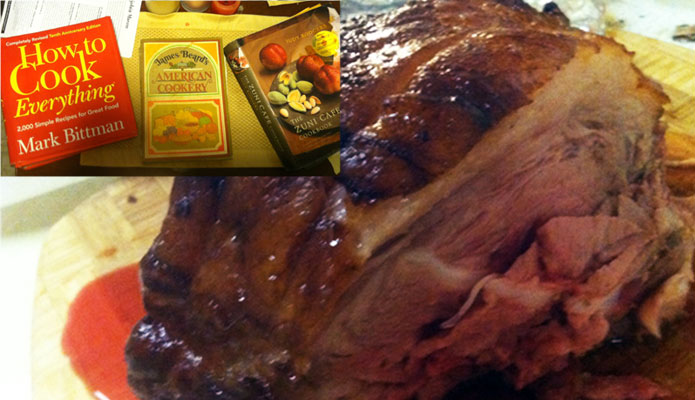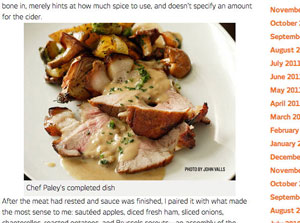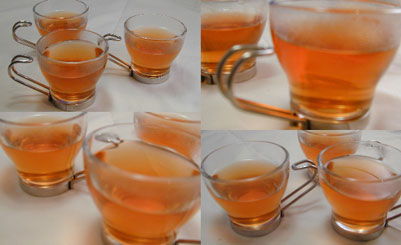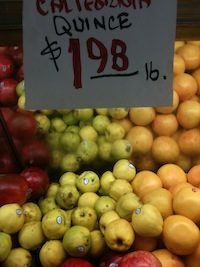My favorite fall meal (so far)

I've made the below meal twice so far this fall and it's fantastically autumnal. Also, fairly forgiving to prepare. I basically stumbled across the main course flipping through one of my go-to cookbooks after aimlessly picking up a handsome chunk of pork shoulder from the butcher. Words like "with Cider and Cream" tend to jump out at me.
-
Shoulder of Pork with Cider and Cream
American Cookery, James Beard.
Online recipe (photo)
Basting seems to be out of fashion right now, but it really works here; you'll be able to taste the apple cider in the finished roast, and the juice that doesn't stick to the meat or (blackened) to the pan will end up flavoring the cream gravy. The apple flavor compliments the nutmeg/ginger/salt rub very well.
Notes:
- You'll notice the recipe is technically for a "leg of pork;" Beard says later in the chapter to treat shoulder "in the same fashion as leg of pork."
- My copy of the cookbook (1972) calls for an internal temp of 165. You'll notice the one on the website calls for an internal temp of 145. Between you and I, an internal temp of 130 when removing from the oven is probably ideal, assuming high quality meat (if the meat is cheap/factory farmed, go to 145). You'll get an extra 5-10 degrees in the center after resting.
- The recipe calls for a ~10 pound roast, a whole shoulder or leg. I used a partial shoulder about half that weight each time. That ran about $40 at my fancy schmancy butcher, but you'll obviously get a lot of mileage out of that much meat.
- He does a thing where you flame the roast with applejack. I forgot to do this the first time and honestly I'm not sure it made any difference at all. The second time I forgot to remove my insta-read thermometers before flaming so now they look like this. Anyway, don't go out and buy a bottle of applejack for this recipe.
- If you do a half recipe you'll likely end up with some blackened apple cider on the bottom of your pan (there are fewer fat drippings to absorb heat and keep the cider from steaming and reducing). Don't panic, everything is fine. The black bits will stick and stay out of the drippings you use for the gravy, and you can get them off with some Bon Ami or Comet after an overnight soak. (To minimize this, go heavier on the basting, and baste more frequently, early in the cooking, to cool off the bottom of the pan.)
- Notice how the gravy involves pan juices, heavy cream, butter, and egg yolks? To pour on your fat laden shoulder roast? Ha ha, delicious heart disease. Anyway, you can skip the whole last part of the gravy recipe, where you stir in the yolk(s) and remaining cream. I did this on accident the first time and frankly I thought the gravy was better. It's, uh, just a little heavy with the yolks and extra cream in there.
- If you do a half roast (5 lbs), don't forget to cut the gravy recipe in half too!
-
Buttermilk mashed potatoes
The Zuni Cafe Cookbook, Judy Rodgers.
Online recipe
This is one of the top two or three standout recipes in this fantastic cookbook, along with the famous Zuni Roast Chicken with Bread Salad, the sublime rosemary roast potatoes, and the wonderful polenta, hanger steak, short ribs, oxtail, and brasato recipes (among others!) You should buy this cookbook! "The Practice of Salting Early" section alone is worth the cover price. If you are a meat eater, it will change your life. Or should, at least.
Notes:
- The online recipe lists milk and cream/half-and-half. Do milk or cream or half-and-half, 2-3 tablespoons total.
- Rodgers recommends that the milk/cream/half-and-half (but not the buttermilk) be hot when mixing in. I achieve this by putting it in a pan set on the stovetop (not a burner) as the roast cooks in the oven. You'll want to add an extra tablespoon or so if you do it this way in case it reduces.
- Rodgers recommends the butter be just melted. You can microwave or do as with the milk in the bullet above.
- Rodgers says to serve immediately "or keep warm, covered, in a double boiler, for up to 30 minutes." I think it's actually superior after 10-30 minutes in the double boiler because it will be warmer than if you serve it straightaway. Also, it greatly reduces the stress of timing the different courses since now you have a broader window for serving. If you do the double boiler, it's easiest to reserve the water you boiled the potatoes in, since it will already be hot.
- Don't slack on the whipping, especially after the last addition (butter). Get the potatoes nice and fluffy! (The potatoes in the image above are underwhipped.) And make sure there is enough salt in there.
- Did you buy the cookbook yet? Go buy it! The roast chicken and bread salad are just staggering.
-
Fennel Baked in Stock and Tomato Sauce
Adapted from How To Cook Everything, Mark Bittman.
Online recipeThe strong anise flavor of the fennel stands up well to all the fatty flavor in the other dishes, as does the tomato sauce.
The original Bittman recipe is just "baked in stock" but I was lacking in stock so filled around half the required liquid with juice from my whole canned tomatoes (think San Marzano or Muir Glen). The rest was either stock and/or water with wine and/or dry vermouth. The recipe is typical of Bittman - simple, easy, absolutely delicious (buy his cookbook too, if you haven't).
Notes:
- Replace half the stock with tomato sauce, such as the juice from a can of San Marzano whole tomatoes.
- Pretty sure I skipped the Parmesan. You're, uh, probably getting enough dairy in the other two dishes.
Eat with a hearty, casual red table wine (Côtes du Rhône, Sangiovese, Syrah, etc.) or a nice beer. Happy autumn!


